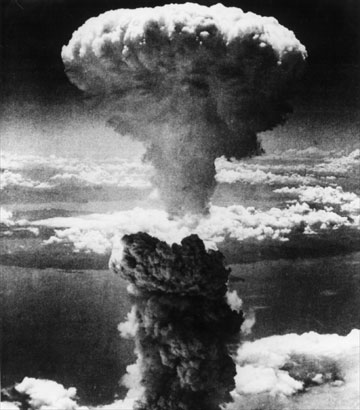"Nature" reports about new findings in radiation protection

First-time measurement of neutron doses in Hiroshima
Scientists from Munich and the USA, for the first time, succeeded in measuring the neutron doses to which the survivors of the nuclear bomb explosion in Hiroshima had been exposed to. The precise knowledge of these quantities is very important for radiation protection: Because the knowledge about long term effects of ionizing radiation in humans is mostly based on examinations of the nuclear bomb explosions in Japan. To determine the limits used in international radiation protection, diseases like Leukemia and Tumors in survivors are put into relation with gamma and neutron doses they had been exposed to.
The renowned scientific magazine Nature, on July 31st 2003, published the results of scientists from the Faculty of Physics of the Technische Universität München, the Strahlenbiologisches Institut of the Ludwig-Maximilians-Universität München, the Lawrence Livermore National Laboratory (USA), and the University of Utah (USA).
To determine the neutron doses in the nuclear bomb explosion caused by high energy neutrons, the scientists examined copper samples from Hiroshima, for example lightning rods and rain pipes. In these, they found the radioactive isotope Ni-63, which has also been created by high energy neutrons and is still present today because of its long half-life of 101 years. Since the number of Ni-63 atoms in the samples is very small - as low as 10 Ni-63 atoms in 1018 copper atoms (which is a billion times a billion) - the scientists had to develop special preparation and detection techniques. A key role is played by the Accelerator Mass Spectrometry, which is used at the Maier-Leibnitz-Laboratory for Nuclear and Particle Physics of the two Munich Universities in Garching. In combination with a special detection system, this allows for measurements with world-wide unique sensitivity.
The results of the measurements impressively confirm the estimations of neutron doses, which - mostly based on theoretical assumptions - have been improved again and again over a period of 40 years. At the same time there have always been some doubts about these quantities, where measurements with low energy neutrons, which contributed only little to the neutron doses, played an important role. These doubts have now been erased and the basic assumptions of radiation protection have been confirmed.
Gunther Korschinek, Thomas Faestermann
(Translation: Peter Ludwig)
Literature:
T. Straume, G. Rugel, A.A. Marchetti, W. Rühm, G. Korschinek, J.E. McAninch, K. Carroll, S. Egbert, T. Faestermann, K. Knie, R. Martinelli, A. Wallner, and C. Wallner
Measuring fast neutrons from Hiroshima at distances relevant to atomic-bomb survivors
Nature 424, 539-543 (2003; doi:10.1038/nature01815